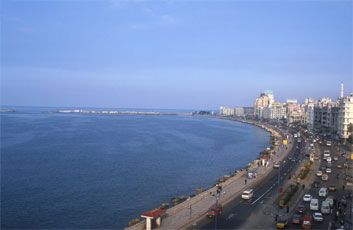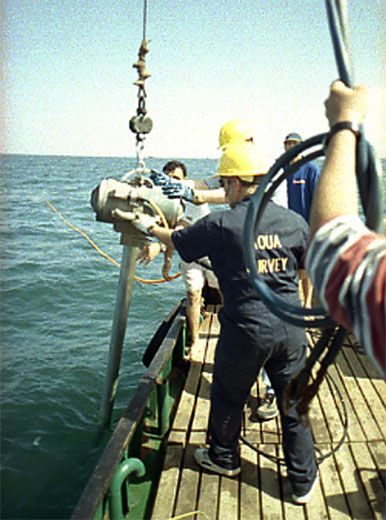Underwater World
New evidence reveals a city beneath ancient Alexandria
/https://tf-cmsv2-smithsonianmag-media.s3.amazonaws.com/filer/alexandria_boat.jpg)
Scientists have found traces of a forgotten city that existed 700 years before Alexander the Great founded Alexandria as part of his efforts to conquer the known world.
While studying Greek and Roman ruins in the waters around the Egyptian city, Jean-Daniel Stanley of the Smithsonian Institution's National Museum of Natural History and his colleagues discovered evidence of building construction that was much older than they had expected.
"It was serendipitous that what we found dates pre-Alexander," says Stanley, whose findings have been published in the August issue of the journal GSA Today. "We thought that there was a city, but you need to have something in hand. We have the first part of it. We have the timing."
Historians have generally agreed that some settlement—a modest fishing village, a more substantial walled center or possibly a fortified settlement—referred to in ancient histories as Rhakotis existed here centuries before Alexander arrived. But until this discovery, they lacked physical evidence.
In 2001, Stanley, working with a team of geologists, anthropologists and geochemists, collected seven underwater sediment core samples measuring three inches wide, 6 to 18 feet long and up to 20 feet underwater from sites scattered across Alexandria's nearly square-mile East Harbor.
The intent of the study had been to look at how catastrophic and human events contribute to cities submerging, and to apply the findings to cities like New Orleans and Venice. But, as Stanley and his colleagues have now confirmed, they ended up finding five critical indicators of human activity, including ceramics; rock fragments derived from Middle and Upper Egypt; and significant amounts of lead, heavy minerals and organic matter, dating back to 1,000 B.C.
Four years later, Stanley and his colleagues embarked on a more systematic study to confirm his discovery of the buried settlement, analyzing the sediment through archaeological, stratigraphical, petrological and geochemical methods. Among other tests, the researchers compared the site's ceramic fragments with those typical of the southeastern Mediterranean in the ninth to seventh centuries B.C. On average, Stanley found three to four traces of human activity in each sediment core.
"Looking at any one indicator [of human activity], you could find an explanation," Stanley says. "But the fact that you have five independent parameters—that's very robust evidence. I'd say it's a safe bet."
Typically, the top two layers of sand and mud in cores from East Harbor and mainland Alexandria contain pottery fragments, high concentrations of heavy minerals, organic waste, lead, quartz and crystalline and limestone, because these layers correspond to the era of rapid municipal development that occurred during the reign of the Ptolemies and Romans. Heavy construction, metallurgic activity and sewage runoff account for these remnants.
Until now, however, similar indicators had not been found in layers dated to pre-Greek times. Stanley and his colleagues extracted pottery fragments from locally produced cooking containers, heavy minerals and organic matter—all from sediment radiocarbon-dated back to seven centuries before 332 B.C.
The clinchers, says Stanley, are the concentration and composition of the lead found in one of the pre-Greek layers. The lead concentration was markedly higher than that found in sediments known to precede human contact—suggesting the presence of people—but milder than that from post-Alexander times. And while post-Alexander lead came from metallurgy, the lead in the pre-Greek layers was derived from clay used in pottery and mortar.
Both findings confirm not only human activity but also human activity in a distinctly different time and settlement than Alexandria, says Richard Carlson, a geochemist with the Carnegie Institution of Washington, D.C. who conducted the lead analysis and interpretation.
"The enhanced lead signal in the pre-Alexander sediment indicates that they were importing a substantial amount of clay and building a settlement," Carlson says. The lead composition changed in the post-Alexandria period, he says, with the increased use of metallurgy, paints and pigments.
Stanley and his colleagues are hesitant to make larger speculations about Rhakotis at this point, shying away from describing it as industrial but suggesting it may not be as modest as originally conceived.
"We've got evidence of humans—a good, hard base that there is something there," Stanley says. "Now that we've established this baseline, intense work could do an awful lot in this next decade to highlight where this town was, who was in it, and what they were doing."
/https://tf-cmsv2-smithsonianmag-media.s3.amazonaws.com/accounts/headshot/megan.png)


/https://tf-cmsv2-smithsonianmag-media.s3.amazonaws.com/accounts/headshot/megan.png)